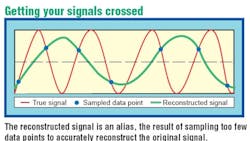MSD 101: Senors & Signals
Unlike their analog counterparts, digital controllers don't read every point of a signal. Instead, they read, or sample, just enough points to construct a reasonable facsimile. Because of the way they work, digital controllers can more easily filter out noise and other undesirable information than analog controllers, resulting in faster and better control. The trick is to find the right sample rate.
The minimum rate to get an accurate reproduction of a waveform, called the Nyquist frequency, is twice the highest frequency component in the signal of interest. Faster signals obviously require faster sampling rates. At some point, however, the data acquisition circuits reach their limit, and anything beyond that is likely to be reproduced incorrectly.
Once you set your sampling rate, corresponding to a particular signal frequency, it's often a good idea to filter out higher frequencies. This way, if there's any high-frequency noise in the environment, it won't degrade the measurement.
Questions & Answers
Q. What does over-sampling mean?
A. Oversampling is a little like signal processing insurance. Basically, it says your sampling rate is so many times higher than the Nyquist rate.
Q. My acquisition board has a sampling rate of 200 kHz. The highest frequency I can resolve, however, is 25 kHz. What's wrong?
A. You're probably looking at four channels of data. Each channel is sampled once every four system sampling intervals or every 20 μsec. In a multiplexed system, the sampling rate per channel is the overall rate divided by the number of channels.
Q. I'm sampling a signal within the range of my system, but I keep getting inconsistent results. Why?
A. It could be that your signal contains some spurious high-frequency noise. An anti-aliasing filter should help.
